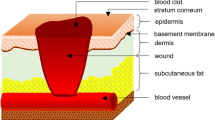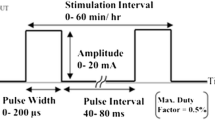Abstract
The healing of a cutaneous wound is accompanied by endogeneous electrical phenomena. Not knowing whether they represent merely a side-effect of the physiological processes which take course during healing or whether they play a much more important role as mediators of healing, externally applied electricity was examined as a therapeutic tool for the enhancement of natural regenerative processes. In the present review a historical literature survey dealing with human applications of electric current for wound healing acceleration is given. It presents a complete palette of heterogeneous studies, differing in the parameters of applied electric current, in delivery modes as well as in the types of wounds being stimulated. Because of all these differences, comparing the efficacy of the described methods is difficult and could hardly be objective. Therefore greater stress was laid upon the discussion concerning the problems in designing clinical studies (size of the sample observed, control group, ethics of the procedures), rationales for the employment and possible underlying mechanisms of particular methods, and problems of evaluating their efficacy. In spite of the extensive work performed in the field of electrical wound healing we remain only part way towards explaining the mechanisms by which electricity reinforces the regenerative capabilities of injured tissue as well as only part way towards the selection of the optimal stimulation method from among the published reports.
Similar content being viewed by others
References
Akers, T. K. andGabrielson, A. L. (1984) The effect of high voltage galvanic stimulation on the rate of healing of decubitus ulcers.Biomed. Sci. Instrum.,20, 99–100.
Alon, G., Azaria, M. andStein, H. (1986) Diabetic ulcer healing using high voltage TENS (abstract).Phys. Ther.,66, 775.
Altman, D. G. (1985) Statistics and ethics in medical research. InStatistics in practice. British Medical Journal (Ed.), British Medical Association, London, 1–26.
Alvarez, O. M., Mertz, P. M., Smerbeck, R. V. andEaglstein, W. H. (1983) The healing of superficial skin wounds is stimulated by external electrical current.J. Invest. Dermatol.,81, 144–148.
Assimacopoulos, D. (1968a) Wound healing promotion by the use of negative electric current.Am. Surg.,34, 423–431.
Assimacopoulos, D. (1968b) Low intensity negative electric current in the treatment of ulcers of the leg due to chronic venous insufficiency.Am. J. Surg.,115, 683–687.
Augustinsson, L. E., Carlsson, C. A., Holm, J. andJivegard, L. (1985) Epidural electrical stimulation in severe limb ischemia. Pain relief, increased blood flow and a possible limb-saving effect.Ann. Surg.,202, 104–110.
Barker, A. T., Jaffe, L. F. andVanable, J. W. (1982) The glabrous epidermis of cavies contains a powerful battery.Am. J. Physiol.,242, R358-R366.
Boag, J. W., Haybittle, J. L., Fowler, J. F. andEmery, E. W. (1971) The number of patients required in a clinical trial.Br. J. Radiol.,44, 122–125.
Carey, L. C. andLepley, D. (1962) Effect of continuous direct electric current on healing wounds.Surg. Forum.,13, 33–35.
Carley, P. J. andWainapel, S. F. (1985) Electrotherapy for acceleration of wound healing: low intensity direct current.Arch. Phys. Med. Rehabil.,66, 443–446.
Cook, A. W. andWeinstein, S. P. (1973) Chronic dorsal column stimulation in multiple sclerosis. Preliminary report:NY State J. Med.,73, 2868–2873.
Cook, A. W., Oygar, A., Baggenstos, P., Pacheto, S. andKlenige, E. (1976) Vascular disease of the extremities: electrical stimulation of the spinal cord and the posterior roots.,76, 366–368.
Cunliffe-Barnes, T. (1945) Healing rate of human skin determined by measurement of electric potential of experimental abrasions; study of treatment with petrolatum and with petrolatum containing yeast and liver extracts.Am. J. Surg.,69, 82–88.
Cuono, C. B. (1985) Physiology of wound healing. InCutaneous wounds.Dagher, F. J. (Ed.), Futura Publishing Co. Mount Kisco, New York, 1–22.
Dayton, P. D. andPalladino, S. J. (1989) Electrical stimulation of cutaneous ulcerations.J. Am. Podiatr. Med. Assoc.,79, 318–321.
DuBois-Reymond, E. (1860) Untersuchungen über tierische Elektrizität.Reimer Berlin,2, 2–68.
Edel, H. andFreund, R. (1975) Gleichstrombehandlung chronischer Hautulzera und sekundär heilender Wunden.Zschr. Physiother.,27, 457–464.
Fox, E. andMelzack, R. (1976) Transcutaneous electrical stimulation and acupuncture: comparison of treatment for low back pain.Pain,2, 141–148.
Gault, W. R. andGatens, P. F. (1976) Use of low intensity direct current in management of ischemic skin ulcers.Phys. Ther.,56, 265–269.
Ginsberg, A. J. (1934) Ultrashort radio waves as a therapeutic agent.Med. Record,19, 1–8.
Goldin, J. H., Broadbent, N. R. G., Nancarrow, J. D. andMarshall, T. (1981) The effects of Diapulse on the healing of wounds: a double-blind randomised controlled trial in man.Br. J. Plast. Surg.,34, 267–270.
Graber, J. N. andLifson, A. (1987) The use of spinal cord stimulation for severe limb-threatening ischemia: a preliminary report.Ann. Vasc. Surg.,1, 578–581.
Herlitzka, A. (1910) Ein Beitrag zur Physiologie der Regeneration.Wihelm Roux Arch.,10, 126–158.
Ieran, M., Zaffuto, S., Bagnacani, M., Annovi, M., Moratti, A. andCadossi, R. (1990) Effect of low frequency pulsing electromagnetic fields on skin ulcers of venous origin in humans: a double-blind study.J. Orthop. Res.,8, 276–282.
Illingworth, C. M. andBarker, A. T. (1980) Measurement of electrical currents emerging during the regeneration of amputated fingertips in children.Clin. Phys. Physiol. Meas.,1, 87–89.
Illis, L. S., Sedgwick, E. M. andTallis, R. C. (1980) Spinal cord stimulation in multiple sclerosis: clinical results.J. Neurol. Neurosurg. Psychiatry,43, 1–14.
Illis, L. S. (1982) The effects of repetitive stimulation in recovery from damage to the central nervous system.Int. Rehab. Med.,4, 178–182.
Jaffe, L. F. andVanable, J. W. (1984) Electric fields and wound healing.Clin. Dermatol.,2, 34–44.
Jeran, M., Zaffuto, S., Moratti, A., Bagnacani, M. andCadossi, R. (1987) PEMF stimulation of skin ulcers of venous origin in humans: preliminary report of a double blind study.J. Bioelectr.,6, 181–188.
Jivegard, L., Augustinsson, L. E., Carlsson, C. A. andHolm, J. (1987) Long-term results by epidural spinal electrical stimulation (ESES) in patients with inoperable severe lower limb ischaemia.Eur. J. Vasc. Surg.,1, 345–349.
Kaada, B. (1982) Vasodilation induced by transcutaneous nerve stimulation in peripheral ischemia (Raynaud's phenomenon and diabetic polyneuropathy.Eur. Heart J.,3, 303–314.
Kaada, B. (1983) Promoted healing of chronic ulceration by transcutaneous nerve stimulation (TNS).VASA,12, 262–269.
Kaada, B. (1987) Mediators of cutaneous vasodilation induced by transcutaneous nerve stimulation in humans. InNeuronal messengers in vascular function.Nobin, A., Owman, C. andArneklo-Nobin, B. (Eds.), Elsevier Science Publishers, 475–488.
Kanof, N. M. (1964) Gold leaf in the treatment of cutaneous ulcers.J. Invest. Dermatol.,43, 441–442.
Katelaris, P. M., Fletcher, J. P., Little, J. M., McEntire, R. J. andJeffcoate, K. W. (1987) Electrical stimulation in the treatment of chronic venous ulceration.Aust. N. Z. J. Surg.,57, 605–607.
Kloth, L. C. andFeedar, J. A. (1988) Acceleration of wound healing with high voltage, monophasic, pulsed current.Phys. Ther.,68, 503–508.
Kloth, L. C. andFeedar, J. A. (1990) Electrical stimulation in tissue repair. InWound healing: alternatives in management.Kloth, L. C., McCulloch, J. M. andFeedar, J. A. (Eds.), F. A. Davis Co, Philadelphia, 221–256.
Konikoff, J. J. (1976) Electrical promotion of soft tissue repair.Ann. Biomed. Eng.,4, 1–5.
Lombardo, S. S. (1959) Treatment of decubitus ulcers. Symp. A. J. Ginsberg Foundation for Medical Research, 29th June, New York, 13–17.
Long, D. andHagfors, N. (1975) Electrical stimulation in the nervous system: the current status of electrical stimulation of the nervous system on pain relief.Pain,1, 109–123.
Meglio, M., Cioni, B., Dallago, A., de Santis, M., Pola, R. andSerricchio, M. (1981) Pain control and improvement of peripheral blood flow following epidural spinal cord stimulation.J. Neurosurg.,54, 821–823.
Resch, S. C., Kerner, E., Robson, M. C., Heggers, J. P., Scherer, M., Boertman, J. andSchileru, R. (1988) Pressure sore volume measurement.JAGS,36, 444–446.
Richardson, R. R., Cerullo, L. J. andMeyer, P. R. (1979) Autonomic hyperreflexia modulated by percutaneous epidural neurostimulation: a preliminary report.Neurosurg.,4, 517–520.
Robertson, W. G. A. (1925) Digby's receipts.Ann. Med. History,7, 216–219.
Ross, J. (1981) Results, theories and concepts concerning the beneficial effects of pulsed high peak power electromagnetic energy (Diapulse therapy) in accelerating the inflammatory process and wound healing. The Bioelectromagnetic Soc., 3rd Ann. Conf. Washington DC, 9th–12th Aug., 18–21.
Rowley, B. A., McKenna, J. M., Chase, G. R. andWolcott, L. E. (1974) The influence of electrical current on an infecting microorganism in wounds.Ann. NY Acad. Sci.,238, 543–551.
Shealy, C. N., Mortimer, J. T. andReswick, J. B. (1967) Electrical inhibition of pain by stimulation of the dorsal columns: preliminary clinical report.Anesth. Analg.,46, 489–491.
Siegfried, J., Krainick, J. U., Haas, H., Adoriani, C., Mayer, M. andThoden, U. (1978) Electrical spinal cord stimulation for spastic movement disorder.Appl. Neurophysiol.,41, 134–137.
Stefanovska, A., Vodovnik, L., Benko, H. andTurk, R. (1993) Treatment of chronic wounds by means of electric and electromagnetic fields. Part 2 The value of FES parameters for pressure sore treatment.Med. & Biol. Eng. & Comput.,31 (in press).
Tallis, R. C., Illis, L. S., Sedgwick, E. M., Hardwidge, C. andGarfield, J. S. (1983) Spinal cord stimulation in peripheral vascular disease.J. Neurol. Neurosurg. Psychiatry,46, 478–484.
Thomas, D., Lassaux, G., Bocquillon, S. andDaumard, N. (1982) Traitement d'une escarre de decubitus par electrostimulation—premier resultat a propos d'un cas.Cah. Kinesither.,93, 57–63.
Thurman, B. F. andChristian, E. L. (1971) Response of a serious circulatory lesion to electrical stimulation: a case report.Phys. Ther.,51, 1107–1110.
Valenčič, V. (1989) Large scale two-dimensional finite difference model of sacral bed sore. Proc. 3rd Vienna Int. Workshop on Functional Electrostimulation, 211–214.
Weiss, D. S., Kirsner, R. andEaglstein, W. H. (1990) Electrical stimulation and wound healing.Arch. Dermatol.,126, 222–225.
Westerhof, W. andBos, J. D. (1983) Trigeminal trophic syndrome: a successful treatment with transcutaneous electrical stimulation.Br. J. Dermatol.,108, 601–604.
Wheeler, P. C., Wolcott, L. E., Morris, J. L. andSpangler, M. R. (1971) Neural considerations in the healing of ulcerated tissue by clinical electrotherapeutic application of weak direct current: findings and theory. InNeuroelectric research.Reynolds, D. V. andSjoberg, A. E. (Eds.), Charles Thomas Publications, Springfield, 83–99.
Wolcott, L. E., Wheeler, P. C., Hardwicke, H. M. andRowley, B. A. (1969) Accelerated healing of skin ulcers by electrotherapy: preliminary clinical results.South. Med. J.,62, 795–801.
Wolf, M., Wheeler, P. C. andWolcott, L. E. (1966) Gold-leaf treatment of ischemic skin ulcers.JAMA,196, 693–696.
Author information
Authors and Affiliations
Rights and permissions
About this article
Cite this article
Vodovnik, L., Karba, R. Treatment of chronic wounds by means of electric and electromagnetic fields part 1 literature review. Med. Biol. Eng. Comput. 30, 257–266 (1992). https://doi.org/10.1007/BF02446963
Received:
Accepted:
Issue Date:
DOI: https://doi.org/10.1007/BF02446963




